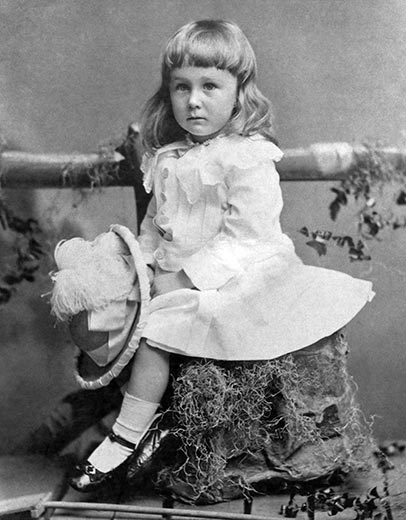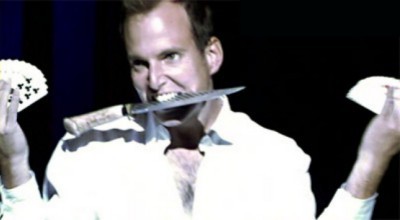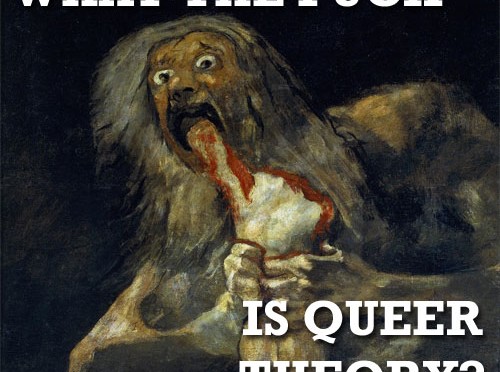Did some Ed Hardy-wearing bro just engage you in conversation about the importance of whey protein in a lifting regiment, the nuance of Family Guy, and his cultured soft side? This dude listens to Gotye, but only when his bros aren’t around.Did you know this bro is really just a byproduct hetero-patriarchal ableist powers relations? You see, said broseph is just performing his gender role. That gender role has come into being after centuries of fine-tuning in the service of capitalism, nationalism, and probably some other isms. And, on the flip side, this system produced docile women to feed said broseph and pump out his children who in turn will grease the wheels of those aforementioned isms.
And that’s where queer theory comes in. It’s not really fair to write a short guide to queer theory. Queer theory is a diverse field of studies that involves a lot of disparate ideas. It’s a rapidly expanding body of literature that seeks to answer a series of questions about what is normal, how normal comes to exist, and who is excluded or oppressed by those notions of norms. In bed. So queer theory celebrates the figure of the queer, or more specifically, the act of queering. Drag queens, two-spirit peoples, as well as those who don’t quite live up to their gender expectations are disrupting the narratives that build the capitalist state.
So what does queer theory teach us?
Gender is an Evil State Apparatus
The ideas we have in our head about what constitutes male-ness, female-ness, and what constitutes “normal” are all socially constructed. As Hennessy Youngman reminds us, it’s like your father who tells you all these stories when you’re young. What’s good, what’s evil, etc. And then queer theory comes along and is like “fuck your father, fuck his narratives, and fuck his essential structures“…in bed. Queer theory explains that we are constantly performing these narratives and structures of male-ness, female-ness, straight-ness, normal-ness, etc. When you get up in the morning, put on a skirt, and desperately try to find a husband before your overbearing mother considers you a failure, you’re taking part in a production of power in which we’re all implicated.
Judith Butler argues in Gender Trouble that gender works through a performance, which cites previous performances to justify itself. So, when Franklin Delano Roosevelt grew up wearing a dress, it was a totally acceptable practice. Up until the age of six, the dress Roosevelt is donning is considered gender-neutral. Now, to dress a male child as such is considered an act of sexual deviance performed by the Satan-fueled left wing gay agenda.

So that bro in the Ed Hardy shirt chugging a can of Four Loko after a long day of anabolic-steroid fueled iron pumping isn’t just a raging douche monster. He’s also performing a very specific and historically defined notion of masculinity, gender and sexuality that are entangled in a complex matrix of power. That douche monster is both the perpetrator and victim of compulsive heterosexuality which maintains state power. That’s because in the advent of bourgeois society, what was “normal” was often dictated by what was economically viable. Therefore, men had to be manly and virile to create little children factory workers while women had to be loving and nurturing to raise those children until they were ready for the coal mines at the ripe age of 8.
With that in mind, the idea of gender and sexuality as we understand it tends to seem a little pointless. Boys are raised to be heterosexual manly man only for the sake of conquering distant resource-rich lands. If you ever wondered why Hitler was so intent on promoting sports and outdoor clubs, its for the exact same reason the rest of Europe did. Its great for an imperialist war machine.
So how do we break down these ideas of masculinity and heterosexuality that prop up the state? Queer theory has an answer.
Fucking: It’s Political
From the assertion that power trickles down to our every-day behavior a conclusion was made: the personal is political. Now, lots of Marxists and other critical theorists got into a tizzy about this and it’s still being bitterly disputed. One side believes that historical materialism is the only thing that matter and the other side thinks people have agency (go ahead, start the hate mail and lecture me on the nuances of post-Marxism). So if refusing to perform the script of hetersexuality is radical, than the same applies for non-heterosexual sex. Thinkers like Lee Edelman (who will be discussed later) even think sodomy is the key to capitalism’s destruction.

So some queer theorists have proposed the idea of genderfuck as a political strategy for disrupting the heteronormative narrative. Genderfucking, which begat the most unfortunate name of a Wikipedia section ever, is not limited to sex but also includes drag, cross-dressing and other forms of gender bending. In “Genderfuck: The Law of the Dildo“, June Reich claims that “genderfuck structures meaning in a symbol-performance matrix that crosses through sex and gender, and sexual practice.”
Other queer theorists have taken the idea of destablizing sexual practices and put it into the context of a larger political metaphor. J.K. Gibson-Graham, for instance, makes the best academic anal sex joke ever:
What if we were to ‘queer’ capitalist hegemony and break apart some of its consolidating associations? We could start by reimagining the body of capitalism, that hard and masculine body that penetrates non-capitalism but is not itself susceptible to penetration (this image conveys some of the heterosexism that structures contemporary social theory)…But how might we re-envision that body as more open and permeable, as having orifices through which non-capitalism might enter?…What violence do we do to these when we normalise all commodity production as capitalist commodity production? Surely the market is a mobile and membranous orifice into which can be inserted all kinds of non-capitalist commodities, whose queer presences challenge the pre-eminence of capitalism and the discourses of its hegemony.
But speaking of destabilizing sexual norms by queering things up, the queer community hasn’t been the best at destabilizing all norms. Within gay and lesbian culture has emerged its own forms of transphobia and “ideal” forms of sexual existence. If you’re too feminine and a gay male, you’ll be berated as being a fairy. If you’re a lesbian who practices BDSM, certain feminists think you hate women. Benjamin Grimwood even found it necessary to call out the queer community for hating on foot fetishes.
..The proliferation of aberrant sexualities through psychiatry has engendered a contemporary discourse of power, whereby the homosexual is hegemonic and legitimized and the paraphile, manic and marginalized… Many deconstruct “traditional” sex organs and neglect other parts of the body that can be sources of sexual pleasure…For example, the “podophile” desires feet, the “nasophile” desires the nose, the “adipophile” desires fat flesh. Sexual engagements with such stimuli comprise “fetishes” which continue to be socially and medically pathologized. Western society at large thinks of a paraphilia as a sub-category to one’s ontological sexual preference: heterosexuality, homosexuality, bisexuality, etc.
But it’s not just sex stuff. Queer theory is all about breaking down norms and institutions. From the idea that sexual norms are stupid and capitalist came the conclusion that most norms are stupid and antiquated. And then Lee Edelman came along, and was like “lol, the future? Fuck that noise.”
You Should Feel Justified in Hating All Children Everywhere
Lee Edelman, in his canonical book No Future: Queer Theory and the Death Drive puts forth a simple premise. Children are awful. Well, the figure of the child. You know, the blond-haired, blue-eyed Aryan on the Huggies commercial? Politics is mostly about that little asshole. Edelman opens “The Future is Kids Stuff” (a prelude to No Future) with President Clinton’s appeal to save the children. After all, if you’re not for the children then you’re clearly a rampaging monster intent on destroying the magic of Disney Land. And you hate America. To which Edelman replies, “yes, fuck those kids, and fuck their Disney Land.”

The figure of the child is, for Edelman, the center of political modernity. It’s what binds together the present, future and past. After all, most politicking involves appealing to saving the planet for future generations, or at least destroying the planet so your current monster can get a Hummer for their 16th birthday.
Edelman claims that queers are in a unique position to disrupt the reproduction of the social order by virtue of queer sex’s unreproductive nature. Edelman goes as far as responding to conservative assaults on homosexuality as “degrading to our moral fabric” by completing agreeing with them. Responding to Donald Wildmon’s claim that:
Acceptance or indifference to the homosexual movement will result in society’s destruction by allowing civil order to be redefined and by plummeting ourselves, our children and grandchildren into an age of godlessness. Indeed, the very foundation of Western Civilization is at stake
Edelman says “Yes, you’re absolutely right”:
Dare we take a moment and concede that Mr.Edelman might be right, that the queerness of queer theory should tend precisely toward such a redefinition of civil order itself through a rupturing of our foundational faith in the reproduction of futurity?
Edelman creates the figure of the sinthomosexual. The sinthomosexual is a perpetual nay-sayer in the face of the figural child “whose independent death-driven existence eventually ‘forsakes all causes, all social action, all responsibility for a better tomorrow or for the perfection of social forms’ ” by “repudiating the social.” So the sinthomosexual goes stomping around saying “Fuck your couch! Fuck your social order!”
But that leads to one problem for Edelman and queer theory. Because all this super cool nay-saying and transcendence from societal norms is usually associated with one very specific demography. Which brings us to our next section.
White People Ruin Everything
You see, while Europeans were busy colonizing the world, modes of queer sexuality were alive and well in non-white cultures. While Europeans were busy defining what entailed proper manly activities like wrestling bears and beating your wife, Native American cultures, in particular, were holding on to their own queerness from the onslaught of genocidal white folks. Many Native cultures had a third gender, often called Two-Spirit, that was comprised of feminine and masculine qualities. And of course, it was usually those “sexually deviant” Native peoples that were the first one to be slaughtered by European colonizers. Authors like Scott Morgensen have argued that “the terrorizing sexual colonization of Native peoples was a historical root of the biopolitics of modern sexuality in the United States.”
But the problem isn’t that white people came along and destroyed non-white forms of queer existences long before the Stonewall Riots. Well, that’s also a huge problem. The problem is that modern queer narratives have not only elided their settler-colonial past, but are also centered around the figure of the white affluent male.
Andrea Smith (quoting Hiram Perez) in Queer Theory and Native Studies: The Heteronormativity of Settler Colonialism goes as far as to call queer theory the magician’s assistant to whiteness’ disappearing act.

As Perez notes: “Queer theory, when it privileges difference over sameness absolutely, colludes with institutionalized racism in vanishing, hence retrenching, white privilege. It serves as the magician’s assistant to whiteness’s disappearing act.”17 To extend Perez’s analysis, what seem to disappear within queer theory’s subjectless critique are settler colonialism and the ongoing genocide of Native peoples.The analysis that comes from queer theory (even queer of color critique), then, rests on the presumption of the U.S. settler colonial state.
But it’s not just Smith and Perez who have a beef with queer theory. A whole set of divergent sub-disciplines have emerged to counteract a field that was overwhelmingly dominated by white men. So while Edelman’s sinthomosexual goes stomping around like a queer Godzilla destroying social boundaries, non-privileged queers are marginalized by their lack of this super-human ability to transcend their own social location.
Jasbir Puar argues this is usually implicated in invading countries in the name of “saving” oppressed populations. Think women in the Muslim world. It’s also bent on excluding those “not cool enough” to transcend their social positions, like any queer who won’t throw away their “antiquated” social norms. In Terrorist Assemblages, Puar argues:
Queerness here is the modality through which “freedom from norms” becomes a regulatory queer ideal that demarcates the ideal queer. Arguing that “more reflection on queer attachments might allow us to avoid positing assimilation or transgression as choices.” Sara Ahmed notes, “The idealization of movement, or transformation of movement into a fetish, depends on the exclusion of other who are already positioned as not free in the same way.” Individual freedom becomes the barometer of choice in the valuation, and ultimately, regulation of queerness. Ahmed’s post-Marxian frame focuses on the material, cultural, and social capital and resource that might delimit “access” to queerness, suggesting the queer can be an elite cosmopolitan formulation contingent upon various regimes of mobility. Ironically, “those that have access” to such cultural capital and material resources may constitute the very same populations that may would accuse of assimilation, living out queerness in the most apolitical or conservatively political ways.I am thinking of queerness as exceptional in a way that is wedded to individualism and the rational, liberal humanist subject, what Ahmed denotes as “attachments” and what I would qualify as deep psychic registers of investment that we often cannot account for and are sometimes best seen by others rather than ourselves.
So you can think of queer theory like Neo from The Matrix. It tells you that everything is a lie, that there is no spoon (gender) and you can bend it as you will. And much like Ted Theodore Logan Neo, these masters of The Matrix are super white. It’s not that scholars like Puar argue that transcending social norms is bad. The problem lies in the idea of a “queer exceptionalism” that looks down on people who are too poor or marginalized to say “fuck it, I don’t need any social institutions.” Those institutions, for instance a church, can offer community and resources for someone struggling to survive. And while that church may be preaching hate on Sunday’s, it may also run a food pantry afterwards. The argument isn’t that church is good, but that people also need to eat.
So should you throw away your Edelman books and forget queer theory? Absolutely not. Queer theory is constantly being re-invented for the better. It’s no surprise that a literature base bent on destroying norms is constantly changing its own identity.
Want to learn more about queer theory?
Read some of the books below! The Gay and Lesbian Quarterly also has great articles, though you might need to get access from your academic institution. And of course, this Borderlands open-source journal issue on Ranciere and queer theory is a CT favorite.

